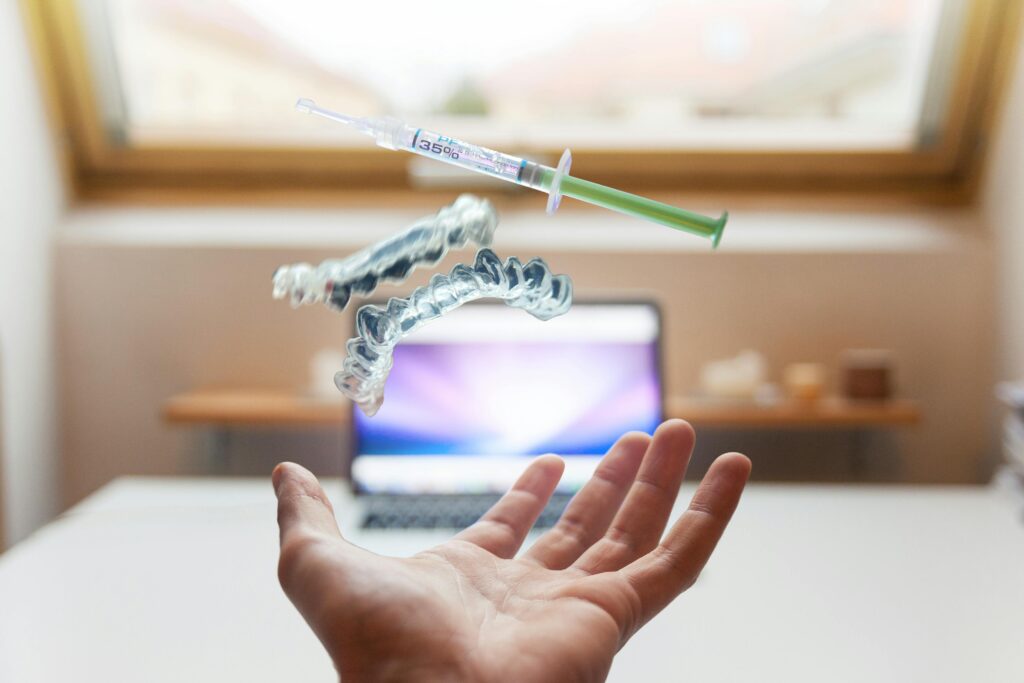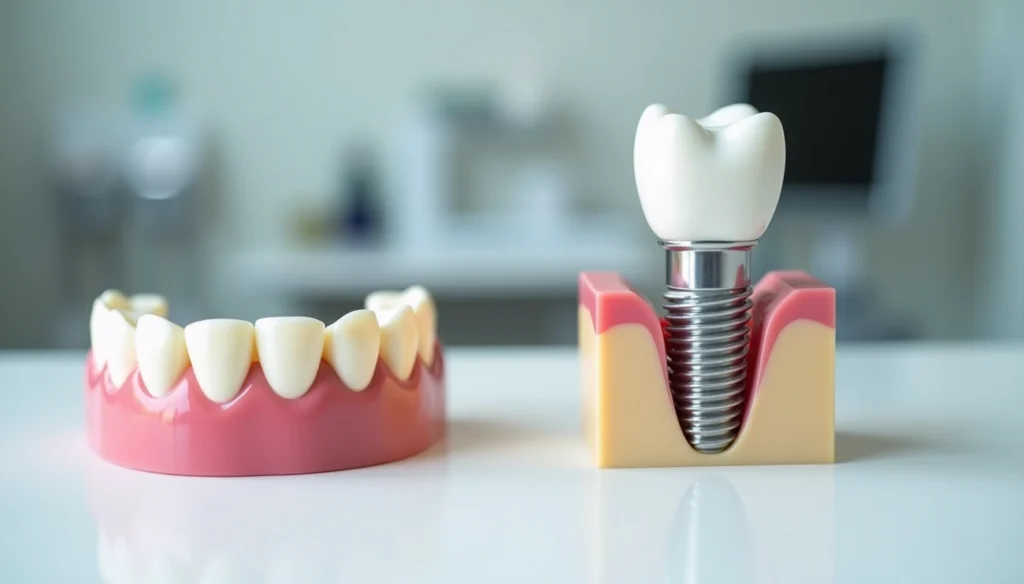Dental implants rank among the most reliable solutions in modern dentistry. The numbers tell the story – 90-95% of implants stay successful beyond 10 years. Patients need to know these tooth replacements offer remarkable durability that blends perfect function with great looks.
These tooth implants last longer than you might expect. Many patients see them working great even after 20 years. The implant itself can serve you for life with good care, but the crown needs replacement around the 10-15 year mark from regular use. The results speak volumes – dental implants keep working well for decades. This makes them worth every penny as a permanent tooth replacement option.
This piece covers everything about how long dental implants last. You’ll learn what affects their durability and the best ways to maintain them. The scientific data shows how they stack up against other options. Anyone looking into getting implants or taking better care of existing ones will find useful, proven information to make smart choices.
What Are Dental Implants and How Do They Work?
Image Source: Dental Partners of Boston
Dental implants are sophisticated tooth replacement systems that work just like natural teeth. These permanent solutions become part of your jawbone, unlike removable dentures that you can take out.
Implant, abutment, and crown: the three parts
Your dental implant has three main components that come together to replace your missing tooth:
- The implant post – A small titanium screw becomes your new artificial tooth root after the dentist places it in your jawbone. This biocompatible metal post gives stability and support to the whole structure.
- The abutment – This connector piece joins the implant post and sits slightly above your gumline. The abutment connects your implant to the visible restoration and will give a perfect fit.
- The crown – You’ll see this part of the dental implant that looks and works like a natural tooth. Your dentist custom-designs this restoration from porcelain or ceramic to complete the implant system.
How osseointegration makes implants long-lasting
Dental implants last so long because of osseointegration – a biological process where bone cells attach themselves to the titanium surface. Dr. Per-Ingvar Brånemark found that there was this remarkable process in the 1960s. The bone cells create a direct structural connection with the implant surface [9, 10].
Your jawbone grows and fuses with the implant surface as you heal. This creates an incredibly strong foundation. The process usually takes 2-6 months to complete. That’s why dental implants can last for decades or even a lifetime if you take good care of them.
Different types of dental implants explained
Your dentist might suggest specific implant types based on what you need:
- Endosteal implants – Most patients get these screw-shaped implants that go directly into the jawbone. They work best if you have enough bone density and healthy gums.
- Subperiosteal implants – These sit on top of your jawbone but under the gum tissue. Dentists rarely use them now because bone grafting lets most patients get endosteal implants.
It also helps to know that All-on-4 implants can replace a full arch of teeth with just four implant posts. Mini dental implants are great options if you have limited space.
How Long Do Dental Implants Last?
Image Source: Sherwood Park Dental Practice
Dental implants stand out as a tooth replacement option because of their amazing durability. Modern dental implants show remarkable staying power throughout a patient’s life, backed by solid clinical research.
Average lifespan of implants vs crowns
Dental implants have two main parts that last different lengths of time. The titanium post that fuses with the jawbone might last a lifetime with good care. The visible crown part needs replacement after 10-15 years from regular wear. Patients should know this difference when they think over the long-term investment. The crown might need a new replacement now and then, but the base stays strong without needing more surgery.
How long do tooth implants last in different areas of the mouth?
The implant’s location in your mouth affects its success rate. Research shows most implants go into the mandibular molar area (25.2%), then the maxillary incisor area (19.9%) and maxillary premolar region (17.2%). Each position has its own survival rate—premolars hit 84.21%, molars reach 87.50%, and front teeth maintain 84.21% success. The implant’s length plays a role too. Those between 10-13mm do better (92.59%) than longer ones over 13mm (81.81%).
Scientific data on implant longevity
Life table analysis shows impressive survival rates—98.9% at 3 years, 98.5% at 5 years, 96.8% at 10 years, and 94.0% at 15 years. The largest longitudinal study found about 4 out of 5 implants stay successful after 20 years. Patient-level success rates reach 97.4% at 3 years, 96.7% at 5 years, 92.5% at 10 years, and 86% at 15 years. Single implants do better with a 10-year survival rate of 98.2% than multiple implants at 90.2%.
Tooth implant: how long does it last compared to bridges or dentures?
Dental implants last longer than other tooth replacement options. Traditional dental bridges usually need replacement after 10-15 years. Dentures last even less time, about 5-8 years, because jawbones change shape and wear down. Dental implants cost more upfront but offer better value over time thanks to their durability and lower maintenance needs. They also keep your jawbone healthy by stimulating it, which helps them work better longer.
What Can Shorten the Lifespan of a Dental Implant?
Image Source: MDPI
Dental implants are built to last, but certain factors can cut their lifespan short. Patients who understand these risks can protect their investment and make their implants last for decades.
Poor oral hygiene and peri-implant disease
Bad oral hygiene leads the list of reasons why implants fail. Plaque buildup on implant surfaces triggers inflammation in nearby tissues. This creates a condition doctors call peri-implant mucositis. The condition can worsen into peri-implantitis and cause bone loss around the implant. These peri-implant diseases damage tissues faster than periodontitis and prove much harder to treat.
Smoking and alcohol use
Smokers face a much higher risk of implant failure. Research shows failure rates of 11% for smokers compared to 5% for non-smokers. Nicotine cuts off blood flow, slows healing, and stops bone cells from working properly. Heavy drinking doubles the risk of peri-implantitis. The chemicals in alcohol can break down bone tissue.
Medical conditions like diabetes or osteoporosis
Patients with uncontrolled diabetes struggle with implant integration. The condition changes how parathyroid hormone works, blocks bone cell formation, and cuts bone recovery by up to 40%. Osteoporosis makes bones less dense and weaker. This can threaten the stability needed for successful implants.
Teeth grinding and physical trauma
Teeth grinding poses a serious threat to implants. The failure rate jumps to 41% in people who grind their teeth, compared to 12% in those who don’t. Too much force creates tiny movements that prevent proper bone integration.
Surgical errors or poor placement
Implants can fail right away or later due to wrong placement, poor design, lack of planning, or rough surgical handling. The surgeon’s experience level plays a key role in success rates.
How to Make Your Dental Implants Last Longer
Image Source: yaremadental.com
Proper maintenance can turn your dental implant from a decade-long investment into a permanent solution. Your implant’s success depends on good home care routines combined with professional monitoring.
Daily care: brushing, flossing, and rinsing
Good home care starts when you use a soft-bristle toothbrush and non-abrasive toothpaste made for implants. You should brush twice daily and clean your implant area thoroughly. Your flossing needs extra attention – you might want to try specialized tools like implant-specific floss or water flossers that clean hard-to-reach spots. Adding antimicrobial mouth rinses helps reduce bacteria that lead to peri-implantitis.
Avoiding hard foods and bad habits
Your diet won’t have many restrictions after osseointegration happens. Still, some foods can damage your implants. Stay away from hard items like ice and candy, sticky foods such as caramel and taffy, and anything that needs too much biting force. Don’t use your teeth to open packages or bite fingernails either.
Using night guards for bruxism
Night guards shield your dental implants from grinding damage. A custom-fitted guard spreads pressure evenly across your bite and protects both natural teeth and implant restorations. Patients with bruxism need this protection because their implant failure rate jumps from 12% to 41% without it.
Regular dental checkups and cleanings
Your dentist should see you every six months for cleanings. These visits let them check your implant’s condition, clean difficult spots, and catch problems early. Professional cleaning removes plaque that home care might miss.
Lifestyle changes that support implant health
Smoking and heavy drinking can harm your implant’s success rate substantially. Your diet should include foods rich in vitamins C and D to help with osseointegration. Try eating fatty fish, fortified milk, eggs, and citrus fruits.
Conclusion
Dental implants stand out as a remarkable breakthrough in tooth replacement technology. They offer exceptional longevity compared to traditional options. The titanium posts can last a lifetime with proper care, though you’ll need crown replacements every 10-15 years due to normal wear. This makes implants worth the higher upfront investment.
The success rates look impressive no matter where the implant sits in your mouth. Scientific data shows survival rates above 94% even after 15 years. Patients can expect their properly maintained implants to work reliably for decades.
Your implant’s lifespan faces several threats. Poor oral hygiene that leads to peri-implantitis creates the biggest risk. Smoking, heavy drinking, certain medical conditions, and teeth grinding substantially increase failure rates. On top of that, surgical placement errors can compromise even the most promising cases.
You can take specific steps to protect your investment. The keys to implant success include daily care with the right tools, staying away from harmful foods and habits, using night guards when needed, and regular dental visits. Making lifestyle changes like quitting smoking and eating better helps your implant’s long-term health.
Dental implants do more than just fill gaps in your smile. They help preserve your jawbone’s integrity, keep your facial structure intact, and bring back natural function. Most patients find this detailed solution combines the best looks, function, and durability in modern dentistry. While no tooth replacement lasts forever without care, dental implants are the closest match to natural teeth in both appearance and longevity.
FAQs
Q1. How long can dental implants typically last? With proper care, the titanium implant post can last a lifetime, while the crown usually needs replacement after 10-15 years due to normal wear and tear.
Q2. What factors can shorten the lifespan of dental implants? Poor oral hygiene, smoking, excessive alcohol consumption, medical conditions like diabetes, teeth grinding, and surgical errors during placement can all reduce implant longevity.
Q3. How do dental implants compare to other tooth replacement options in terms of durability? Dental implants generally last much longer than traditional bridges (10-15 years) or dentures (5-8 years), making them a better long-term investment despite higher initial costs.
Q4. What daily care routine is recommended for maintaining dental implants? Use a soft-bristle toothbrush and non-abrasive toothpaste twice daily, floss with implant-specific tools, and rinse with an antimicrobial mouthwash. Regular dental check-ups are also crucial.
Q5. Can lifestyle changes improve the longevity of dental implants? Yes, quitting smoking, limiting alcohol consumption, and maintaining a diet rich in vitamins C and D can significantly support implant health and longevity.



